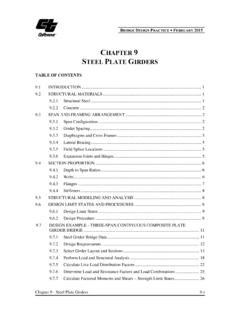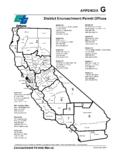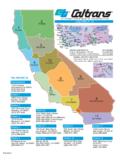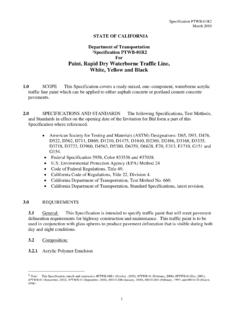Transcription of Chapter 6: Historical Archaeological Resources: Evaluation ...
1 Chapter 6: Historical Archaeological Resources: Evaluation and Treatment TABLE OF CONTENTS. Introduction ..1. Professional Qualifications ..2. Gathering Information ..3. Historical Research ..5. Developing Research Issues ..7. Evaluation of Historical Archaeological Resources ..8. Evaluation Criteria and Integrity ..8. Properties Exempt from Evaluation ..11. Evaluation without Excavation ..13. Letter Reports for Cultural Resources That are Not Eligible ..14. Review, Approval and Distribution of Letter Report ..15. Test Excavations ..15. Time Required to Conduct XPI Studies and Phase II Investigations ..16. Scope and Objectives ..17. Excavation Proposals ..19. Excavation Proposal Contents ..19. Extended Phase I Proposals ..20. Phase II Proposals ..21. Excavation Proposal Approvals And Distribution ..22. Pre-Field Preparation and Fieldwork ..22. Field Methods ..23. Field Safety ..24. Laboratory Analysis ..25. The Historical Resources Evaluation Report ..26. Determinations of Eligibility.
2 26. Historical Resources Evaluation Reports Without Excavation ..27. Jointly Prepared HRERs ..28. 2014 Update rev: 01/02/15 Page 6:i Volume 2 -Standard Environmental Reference Copyright 2014 California Department of Transportation. All rights reserved. Chapter 6: Historical Archaeological Resources Evaluation and Treatment Historical Resources Evaluation Report Review and Distribution ..29. Environmentally Sensitive Areas ..31. Data Recovery Plans, and Treatment Plans ..31. Data Recovery at Historical Archaeological sites ..32. Treatment Plans ..33. Coordinating Consultant Studies ..34. Construction Monitoring and Post-Review Historical Archaeological Study Permits ..35. Peer Review and Approval of Historical Archaeological Peer Review ..35. Caltrans Review and Approval of Archaeological Documents ..36. Endnote ..37. 2014 Update rev: 01/02/15 Page 6:ii Volume 2 -Standard Environmental Reference Copyright 2014 California Department of Transportation. All rights reserved. Chapter 6. Historical Archaeological Resources: Evaluation and Treatment Introduction This Chapter presents Caltrans' policies and procedures for evaluating and treating Historical Archaeological resources, including sites and districts composed of Historical Archaeological sites.
3 In California, the historic era generally is defined as the period following initial Euro- American exploration in the region and establishment of the first Spanish mission in 1769. Sites, as used in this Chapter , specifically encompass both Historical Archaeological sites and those places identified as Traditional Cultural Properties (TCPs). These procedures have been developed to comply with Section 106 of the National Historic Preservation Act of 1966, as amended, and the provisions of the Section 106 Programmatic Agreement (Section 106 PA i). The same general process is also used for compliance with the California Environmental Quality Act (CEQA); for state-owned cultural resources the provisions in the Public Re- sources Code 5024 Memorandum of Understanding (5024 MOU ii) are used. Throughout this Chapter the term Historical archaeologist means Caltrans staff who are cer- tified as Principal Investigators - Historical Archaeology under the Professionally Qualified Staff (Caltrans PQS) requirements of the Section 106 PA and 5024 MOU and consultants who meet the same qualifications (see Section 106 PA/5024 MOU Attachment 1).
4 For federally assisted state and local projects, as well as state-only projects, there are two types of reports that are used to document Historical Archaeological resources: 1) The Cultural Resources Letter Report (Letter Report) is used only when the provisions of the Section 106 PA do not apply, such as for projects involving tribal land or state-only funds. It is used only to document cultural resources that have no potential for meeting the eligibility criteria for inclusion in the National Register of Historic Places (NRHP);. i First Amended Programmatic Agreement Among the Federal Highway Administration, the Advisory Council on Historic Preservation, the California State Historic Preservation Officer, and the California Department of Transportation Regarding Compliance with Section 106 of the National Historic Preservation Act as it Per- tains to the Administration of the Federal-Aid High-way Program in California, effective January 2014. ii Memorandum of Understanding Between the California Department of Transportation and the California State Historic Preservation Officer Regarding Compliance with Public Resources Code Section 5024 and Gover- nor's Executive Order W-26-92, effective January 2015.
5 2014 Update rev: 01/02/15 Page 6:1. Volume 2 -Standard Environmental Reference Copyright 2014 California Department of Transportation. All rights reserved. Chapter 6: Historical Archaeological Resources Evaluation and Treatment see Section and Exhibit The Letter Report is attached to the project's Historic Property Report (HPSR), or for state-only projects, the Historical Resources Compliance Report (HRCR). 2) The Historical Resources Evaluation Report (HRER) is used to document evaluations of all types of Historical Archaeological resources. Section and Exhibit contain de- tailed instructions for completing an HRER. Caltrans sends the HRER to SHPO as an attachment to the HPSR Section 106 consultation package (see Chapter 2 for guidance on preparing an HPSR and SHPO consultation). For state-only projects, the HRER is at- tached to the HRCR. When Archaeological excavation is required to identify or evaluate a site, the Historical ar- chaeologist prepares a proposal for an Extended Phase I (XPI) or a Phase II excavation (See Exhibits and ).
6 Prior to implementation, a Historical archaeologist who is qualified at the Principal Investigator level peer reviews the document (peer review procedures are dis- cussed more fully below and in Section ). The XPI and Phase II proposals are in-house documents used to guide Caltrans activities. The Historical archaeologist reports the results of excavation and, if appropriate, site Evaluation , in the HRER. Caltrans uses other report for- mats to plan for data recovery or post-review discoveries and to report the results of data recovery (Phase III) studies. This Chapter builds on the guidance contained in Chapter 5 on general Archaeological studies. It begins by discussing the qualifications needed to evaluate different types of Historical ar- chaeological resources. Subsequent sections then discuss the Evaluation process for Historical Archaeological resources that do not require excavation, the Evaluation process for Historical Archaeological resources requiring excavation, the preparation of HRERs, treatment proce- dures necessary to complete the Section 106 process, and compliance procedures for state- only projects.
7 Professional Qualifications Qualifications required for Evaluation and treatment of Historical Archaeological properties are dependent on the nature of the resources present. Multi-disciplinary teams may be necessary. See Chapter 1 Section and Section 106 PA/5024 MOU Attachment 1 for a discussion of minimum standards and guidelines, as well as certification levels under the Section 106 PA. Under the Section 106 PA, staff must meet the minimum qualification levels for Co-Principal 2014 Update rev: 01/02/15 Page 6:2. Volume 2 -Standard Environmental Reference Copyright 2014 California Department of Transportation. All rights reserved. Chapter 6: Historical Archaeological Resources Evaluation and Treatment Investigator (Co-PI) or Principal Investigator (PI) to evaluate Historical Archaeological sites. Exhibit Table 1 describes the PQS levels required to perform Archaeological activi- ties and Table 2 describes PQS levels to complete the accompanying studies and construction monitoring. Those not fully qualified as Historical Archaeological Principal Investigators (PI).
8 May perform many tasks with under direct supervision of Historical archaeologists qualified at the PI level. Note that a Caltrans PQS at the PI level for Historical archeology must peer re- view all Historical Archaeological work completed under the terms of the Section 106 PA. Certification as a Caltrans PQS for PI Historical archaeologist is generally required to assume lead responsibility for evaluating Historical Archaeological sites. PI-level prehistoric archaeol- ogists may also evaluate historic-era Native American Archaeological sites. Co-PI-level Historical archaeologists, under the direction of a PI-level Historical archaeologist, may evalu- ate Historical Archaeological sites that do not require excavation (See Exhibit Table 1). Interdisciplinary Approach Caltrans PQS architectural historians and consultants meeting the same qualifications (see Section 106 PA/5024 MOU Attachment 1) are trained in Historical research, may provide valuable assistance with background research for evaluations of historic-era Archaeological sites, and may need to be consulted prior to evaluating these resources.
9 An effective interdis- ciplinary team includes qualified architectural historians and Historical archaeologists who collaboratively evaluate resources with both built and Historical Archaeological elements, as well as other types of cultural resources such as ruins of buildings and structures, cultural landscapes, battlefields, cemeteries, and the locations of important events. In addition, profes- sionals with knowledge of cultural geography, the history of technology, folklore, and social history, to name a few, also may add valuable insights to understanding material culture. Sometimes this expertise is best obtained via consultant contract. For a discussion of proper- ties requiring study, see Chapter 4 Section for Archaeological properties and discussion of built-environment resources in Chapter 7, particularly Sections and Teams may be created from a combination of District Caltrans PQS, Headquarters PQS, or appropriately qualified consultants. Send requests for assistance from Headquarters staff to the Chief of the Cultural Studies Office (CSO).
10 Gathering Information The amount and types of information needed to complete the Evaluation of a Historical archae- ological site will depend on the type of resource , its integrity, and the quality of available information about it. Caltrans PQS will determine when to contact the appropriate Infor- mation Center for a records search and will specify the level of information needed. Local 2014 Update Page 6:3. Volume 2 -Standard Environmental Reference Copyright 2014 California Department of Transportation. All rights reserved. Chapter 6: Historical Archaeological Resources Evaluation and Treatment agencies should be advised not to order record searches unless Caltrans PQS determine that it is necessary. Historical Archaeological resources that meet the criteria for Properties Exempt from Evalua- tion in Section 106 PA/5024 MOU Attachment 4 clearly have no potential to be eligible for the NRHP and need not be evaluated. Only appropriately qualified Caltrans PQS (Co-Princi- pal Investigator for Historical and prehistoric archaeology and above) or similarly qualified consultants may exempt such properties, as outlined in Attachment 4.













